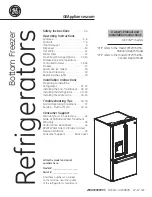
1
2
6.
HINTS AND TIPS
6.1
Normal operating sounds
The following sounds are normal during
operation:
• A faint gurgling and bubbling sound
from coils sound when refrigerant is
pumped.
• A whirring and pulsating sound from
the compressor when refrigerant is
pumped.
• A sudden cracking noise from inside
appliance caused by thermic
dilatation (a natural and not
dangerous physical phenomenon).
• A faint click noise from the
temperature regulator when the
compressor switches on or off.
6.2
Hints for energy saving
• Eco mode / default setting preserves
fresh foods while saving energy.
• Fresh Food Compartment (Fridge):
Most efficient use of energy is
ensured in the configuration with the
drawers in the bottom part of the
appliance and shelves evenly
distributed. Position of the door bins
does not affect energy consumption.
• If the ambient temperature is high
and the temperature control is set to
low temperature and the appliance is
fully loaded, the compressor may run
continuously, causing frost or ice
formation on the evaporator. In this
case, set the temperature control
toward higher temperature to allow
automatic defrosting and to save
energy this way.
• Do not open the door frequently or
leave it open longer than absolutely
necessary.
6.3
Hints for fresh food
refrigeration
• Do not store warm food or
evaporating liquids in the refrigerator.
• Cover or wrap the food, particularly if
it has a strong flavour.
• Position food so that air can circulate
freely around it.
6.4
Hints for refrigeration
Useful hints:
• Meat (all types): wrap in a suitable
packaging and place it on the glass
shelf above the vegetable drawer.
Store meat for at most 1-2 days.
• Cooked foods, cold dishes: cover and
place on any shelf.
• Fruit and vegetables: clean
thoroughly and place in a special
drawer. Bananas, potatoes, onions
and garlic must not be kept in the
refrigerator if not packed.
• Butter and cheese: place in a special
airtight container or wrap in an
aluminium foil or a polythene bag to
exclude as much air as possible.
• Bottles: close with a cap and place on
the door bottle shelf, or (if available)
on the bottle rack.
www.aeg.com
10











































